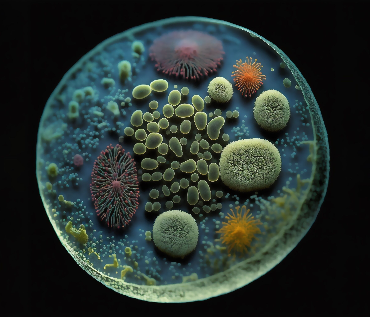Table of content
2. Why is Particle Size Analysis Important?
3. Significance of Microscopic Particle Size Analysis in the Pharmaceutical Industry
4. What Scientific Advances in Particle Size Analysis Have Been Made Recently?
5. Which Factors Primarily Determine Microscopic Particle Size?
6. What Trends are Likely to Govern the Future of Particle Size Analysis?
Introduction
Through the incorporation of cutting-edge technology and novel approaches, particle size analysis, the foundation of several industries and scientific fields, continues to advance. The field of particle size analysis is set for a substantial change as scientists and businesses work to improve the precision, accuracy, and usefulness of characterizing particles. The investigation of innovative techniques, sophisticated apparatus, and data processing procedures is driven by the goal of better comprehending the complex characteristics of particles, from the nanoscale to the macroscale. Particle size analysis will be shaped by this dynamic environment in the future, which promises to lead to better product creation, process optimization, and scientific discoveries in a variety of sectors.
In this exploration of rising developments that are redefining particle characterization, we examine future trends and breakthroughs that will lead to improved materials, goods, and discoveries.
Why is Particle Size Analysis Important?
In a wide range of scientific, commercial, and research domains, the study of microscopic particle size is extremely important. It offers insightful information on the properties of particles, which may have a big impact on the caliber of the final product, the effectiveness of the manufacturing process, the performance of the materials, and scientific knowledge. The following are some of the main justifications for why microscopic particle size analysis is crucial:
1. Quality Control and Assurance: Consistent particle size is important for product quality in sectors including medicines, food & and beverage, cosmetics, and chemicals. Particle size variations can have an impact on a product's overall performance as well as its appearance, texture, stability, and rate of dissolution.
2. Material Performance: The physical, mechanical, and chemical characteristics of materials can be significantly influenced by the size of the particles. Particle size, for instance, can affect attributes like strength, conductivity, reactivity, and thermal properties in the field of advanced materials.
3. Process Optimisation: Understanding the particle size distribution can assist in improving processing conditions, such as mixing, dispersion, filtration, and drying, in manufacturing processes that contain particles. This results in enhanced yields, lower energy use, and higher efficiency.
4. Biomedical and pharmaceutical industries: When developing drugs, active pharmaceutical ingredients (APIs) have a particle size that might affect the bioavailability, rate of drug dissolution, and drug delivery mechanisms. Similarly, it is critical for correct diagnosis and treatment in medical diagnostics to comprehend the size of objects like cells or nanoparticles.
5. Environmental Monitoring: In environmental research, analyzing particulate matter in air, water, and soil can be aided by microscopic particle size analysis. Assessing pollution levels, health hazards, and environmental effects all depend on this data.
6. Nanotechnology: Accurate control of particle size is crucial in the field of nanotechnology. Because of their tiny size, nanoparticles have special features that must be understood and controlled to create useful nanomaterials and nanodevices.
7. Colloid and Surface research: Since particle stability, aggregation, adsorption, and interfacial interactions are all impacted by particle size, understanding particle size is essential in colloid and surface research.
8. Catalysis and Chemical Reactions: In catalysis, reaction rates, selectivity, and overall catalytic effectiveness can all be impacted by particle size. Catalysts can become more effective and affordable by fine-tuning particle size.
9. Characterization of Biological Samples: In biological research, measuring the dimensions of cells, organelles, and biological particles aids in comprehending cellular processes, disease causes, and interactions between biological elements.
10. Research and development: Analysis of microscopic particle size is essential for scientific study in a variety of areas. It aids in understanding the basic characteristics of matter, examining novel events, and creating cutting-edge technology.
11. Regulatory Compliance: As part of quality assurance and control procedures, regulatory bodies in many sectors need precise particle size analysis. The effectiveness and safety of goods are ensured by adherence to these requirements.
12. Product Design and Innovation: Particle size distribution information may help engineers and designers create goods with specified qualities, such as paints, varnishes, inks, and additives.

Significance of Microscopic Particle Size Analysis in the Pharmaceutical Industry
The direct influence that microscopic particle size measurement has on medication efficacy, formulation stability, and regulatory compliance makes it a key component of the pharmaceutical business. The pharmaceutical industry uses microscopic particle size studies as follows:
1. Drug Formulation Development: By gaining a knowledge of how particle size impacts drug solubility, dissolution rate, and bioavailability, pharmaceutical researchers may optimize medication formulations. The creation of the drug's formulation guarantees that it can be adequately absorbed and have the required therapeutic effect.
2. Quality Control: Strict quality control guidelines are followed by the pharmaceutical business. Microscopic particle size analysis makes sure that produced medicinal products always adhere to predetermined particle size criteria, assuring product quality and performance.
3. Enhancing Bioavailability: By comprehending the medication compound's particle size distribution, researchers may create formulations that improve bioavailability. Drug particles may be made smaller via nanotechnology, which can speed up drug absorption in the body and boost dissolution rates.
4. Drug Delivery Systems: The creation of novel drug delivery systems, such as nanoparticles, liposomes, and microparticles, is guided by particle size studies. These technologies can enhance the controlled, sustained, and targeted medication release patterns.
5. Inhalable medications: To guarantee efficient delivery to the lungs, inhalable medications require particles of specified sizes. When developing inhalable drugs for respiratory disorders including asthma and chronic obstructive pulmonary disease (COPD), particle size analysis is crucial.
6. Parenteral Formulations: To avoid aggregation and assure stability during storage and delivery, intravenous and other parenteral formulations require exact control over particle size.
7. Compliance with regulations: As part of the clearance process for new medications, regulatory organizations like the U.S. Food and Drug Administration (FDA) need a thorough characterization of drug particles, including information on their size distribution. Analysis of microscopic particle size yields the information required to satisfy regulatory requirements.
8. Studies on Stability: The stability of medication formulations is tracked throughout time using particle size analysis. The efficacy and safety of the product may be impacted by changes in particle size, which might signify aggregation or deterioration.
9. Dissolution Testing: The speed at which a medication dissolves in a simulated physiological environment is determined through dissolution testing, which is aided by microscopic particle size analyses. The behavior of the medicine in the body may be predicted using this knowledge.
10. Studies of Crystallisation and Polymorphism: Particle size analysis is useful for examining the crystallization and polymorphic forms of medicinal compounds. Different crystal structures may exhibit a range of bioavailability and stability characteristics.
11. Continuous Manufacturing: Real-time particle size monitoring maintains constant product quality throughout the production process.
13. Nanomedicine and targeted therapies: To guarantee that nanoparticles intended for targeted medication delivery may efficiently reach particular tissues or cells inside the body, precise particle size control is necessary.
The pharmaceutical business relies on microscopic particle size analysis to ensure product quality, optimize medication formulations, meet regulatory standards, and advance drug research toward safer and more effective medicines. Many software companies cater to this requirement from the pharmaceutical sector.
Using cutting-edge image analytics software, ImageProVision Technology provides services to the pharmaceutical business. They enable R&D laboratories to accurately determine the size and form of individual particles using a wide range of products, including ipvClass, ipvPSA, ipvAutoClass, and more. Innovative solutions that specifically address the demands of clients in the pharmaceutical industry are ensured by their customer-focused approach.
Whether automating particle categorization, assuring conformance with 21 CFR Part 11, or improving particle counts, ImageProVision's several apps offer high-performance image processing and analysis. Explore ImageProVision's website right away to see how their technology may improve your pharmaceutical production, quality control, and research procedures.

What Scientific Advances in Particle Size Analysis Have Been Made Recently?
We now understand more about particulate matter and its uses in a variety of sectors thanks to substantial scientific developments in the field of particle size measurement in recent years. Let us examine some of the major discoveries and accomplishments in particle size analysis, focusing light on the most recent advancements that are advancing this important field of study.
1. Super-Resolution Microscopy: New super-resolution microscopy methods, like stimulated emission depletion (STED) and structured illumination microscopy (SIM), allow scientists to surpass the diffraction limit of light and achieve resolutions higher than those of conventional optical microscopes. This made it possible to characterize tiny particles in greater detail.
2. 3D Imaging and Tomography: Tomography and confocal microscopy methods were used in conjunction with particle size analysis to offer three-dimensional data on particle structure and distribution. Complex particle systems might now be represented more precisely thanks to these approaches.
3. Automatic image analysis and machine learning: Machine learning methods were being incorporated into software for particle size analysis, allowing for automatic picture identification, segmentation, and size measurement. In data analysis, these algorithms increased efficiency and decreased human error.
4. Quantitative Phase Imaging: Digital holography and interferometric microscopy are two examples of quantitative phase imaging techniques that are becoming more and more well-liked. These techniques made it possible to detect particle size and concentration in an unobtrusive and label-free manner.
5. Correlative Microscopy: Researchers were increasingly using correlative microscopy, which combines multiple imaging modalities to provide comprehensive information about particle characteristics. This method allowed for the integration of data from methods such as light microscopy, electron microscopy, and spectroscopy.
6. Microfluidics and Lab-on-a-Chip: Devices such as microfluidic platforms and lab-on-a-chip devices were being developed for particle analysis.
7. Environmental Scanning Electron Microscopy (ESEM): ESEM was used to investigate wet or uncoated materials, and it was able to do so without the requirement for substantial sample preparation by revealing important details about particle behavior in their unaltered forms.
8. Portable and Field-Deployable Microscopy: Systems for portable microscopy are being developed for field work and on-site analysis. These systems were small, simple to operate, and appropriate for a variety of settings and industries.
9. Integrated Microscopy Systems: Some equipment allowed users to undertake many sorts of analysis without switching instruments by combining various methods into a single system and for instance, combining microscopy and spectroscopy allowed for the simultaneous collection of particle size and composition data.
10. Advanced Sample Preparation Techniques: New sample preparation techniques, such as microfluidic sample handling, have made it possible to analyze particle characteristics more precisely and prevent aggregation.
Software and Data Visualisation: Particle size analysis software was evolving, allowing real-time data visualization, adaptable analytical workflows, and intuitive user interfaces.

Which Factors Primarily Determine Microscopic Particle Size?
Several aspects emphasize the value and applicability of microscopic particle size analysis in a variety of scientific fields and enterprises. While optimizing material qualities in disciplines like materials science and nanotechnology, it provides consistent product quality in industries like chemicals, food, cosmetics, and medicines.
It supports product development and innovation by revealing particle interaction and formulation information. Microscopic particle size measurement is also very important for regulatory compliance, especially in the fields of medicines, healthcare, and environmental monitoring. It enables developments in personalized treatment, targeted medication delivery, and pollution assessment. As nanotechnology develops, particle size analysis helps in the goal of exact control over nanoparticle size.
The multimodal impact of microscopic particle size measurement underlines its relevance across a range of applications, from research to resource management, from health and safety issues to characterizing complex systems.
What Trends are Likely to Govern the Future of Particle Size Analysis?
1. Advanced Imaging Technologies: The continued development of imaging technologies, such as greater resolution microscopy (including super-resolution methods) and enhanced contrast mechanisms, may result in more precise and thorough particle size analyses. These methods might help characterize smaller particles and give us a clearer grasp of particle shape.
2. Machine Learning and Image Analysis: The combination of machine learning algorithms and cutting-edge image analysis methods may revolutionize particle size analysis. Larger datasets could be handled, the measuring procedure could be streamlined, and automated picture identification and analysis techniques might increase accuracy.
3. Multimodal and Correlative Imaging: By combining several imaging techniques, for as combining light and electron microscopy or spectroscopy, it may be possible to characterize particles in more detail. The correlation of several forms of data may provide information on the structure, composition, and behavior of particles.
4. In-situ and Dynamic Analysis: It may be possible to observe particles in real time and place as they engage in dynamic processes or their natural habitats. Studying dynamic systems like colloidal suspensions or biological processes may benefit greatly from this approach.
5. 3D imaging and analysis: By enabling the characterization of intricate three-dimensional structures, improvements in three-dimensional imaging techniques may improve particle size analysis. The use of methods like confocal microscopy, tomography, and holographic imaging may be crucial.
6. Nanoparticle Characterization: To handle ever-tinier nanoparticles, particle size measurement methodologies will need to change as nanotechnology progresses. Innovations may concentrate on precisely measuring sub-100 nanometer-sized particles while taking aggregation and polydispersity into consideration.
7. Quantitative phase imaging: Label-free and non-invasive approaches for particle size analysis may be provided by technologies that quantify phase shifts brought on by particles, such as digital holography and quantitative phase imaging.
8. Portable Devices and Point-of-Care: By creating portable, field-deployable, or even smartphone-based microscopy devices, it may be possible to undertake particle size analysis in distant or point-of-care settings, broadening the scope of these methods' usefulness.
9. Sample Handling and Preparation Advances: Advances in sample handling and preparation procedures might result in more accurate and representative measurements, such as strategies to reduce aggregation or artefacts during imaging.
10. Standardisation and Quality Control: As particle size analysis's significance in many sectors grows, there can be an effort to standardize methodologies, reference materials, and quality control procedures to guarantee accurate and repeatable findings.
11. Applications in the Environment and Biomedicine: It may become more crucial to be able to analyze particles in intricate environmental samples or biological systems. There may be substantial advancements in methods that can address these particular difficulties.
12. Integration of materials and big data Informatics: Integration with more comprehensive materials databases and informatics tools may help shed light on the connections between particle size, composition, and performance across a range of applications.
Conclusion
The future holds interesting developments and improvements in the dynamic field of particle size analysis. We may predict the fusion of machine learning and artificial intelligence as technology develops, enabling quicker and more accurate analysis. Additionally, accessibility and convenience for researchers in a variety of sectors will increase thanks to miniaturization and portable technology. Industry, academic, and governmental partnerships will promote standardization and guarantee the validity of findings. Particle size analysis's potential to revolutionize research and development in the long run by bringing fresh perspectives and answers to a wide range of problems is undeniable. To remain on the cutting edge of particle size analysis in the years to come, keep up with current events and adopt these trends.




